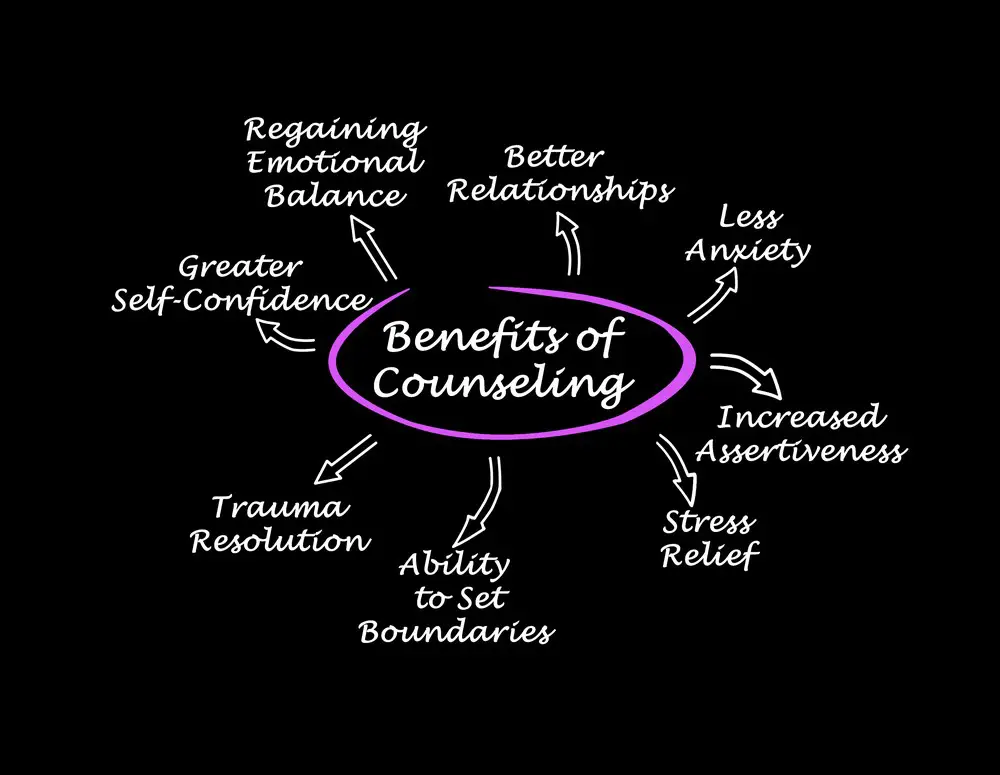As a BetterHelp affiliate, we receive compensation from BetterHelp if you purchase products or services through the links provided
Intensive therapy is a focused approach to mental health treatment that requires frequent sessions over a short period. This type of therapy aims to provide concentrated support and intervention that can lead to significant improvements in mental health conditions. It’s designed for individuals who might need more support than what traditional weekly therapy sessions can offer. You might consider this option if other forms of therapy haven’t met your needs or you’re grappling with issues that require more immediate attention.
Tailored to treat a range of mental health disorders, intensive therapy often includes intensive outpatient programs, which provide you with the opportunity to remain engaged in your everyday life while receiving the treatment you need. Depending on the program’s structure, these programs may involve several hours of therapy per week, including individual, group, and sometimes family sessions. Group therapy plays a pivotal role, as it offers a supportive community aiming to foster growth and recovery among participants.
Key Takeaways
- Intensive therapy offers more frequent support sessions than traditional therapy, aiming for rapid improvement.
- Programs often include individual, group, and family therapy, maintaining engagement with daily life.
- Group therapy is a key component, providing a community that encourages recovery.
Understanding Intensive Therapy
Intensive therapy offers a concentrated level of care designed to help you navigate difficult periods or complex mental health conditions.
Types of Intensive Therapy
 Intensive therapy can be delivered through various programs catering to different needs. Let’s break down the options:
Intensive therapy can be delivered through various programs catering to different needs. Let’s break down the options:
- Cognitive Behavioral Therapy (CBT): This structured method identifies and changes negative thought patterns and behaviors.
- Outpatient Therapy: Regular sessions with a therapist while you continue living at home and possibly maintaining work or school commitments.
- Intensive Outpatient Programs (IOPs): More frequent and more prolonged sessions than traditional outpatient therapy, typically for a few hours multiple days a week.
- Partial Hospitalization: You might spend the majority of your day in a treatment facility for structured therapy but return home at night.
Key Takeaway: Whether it’s adjusting harmful thought patterns through CBT or engaging in an IOP for more resounding support, various programs fit your circumstances.
Benefits of a Structured Program
Joining a structured therapy program can bring significant improvements to your life. Here’s how:
- Consistency and Focus: Regular, focused therapy sessions foster rapid progress.
- Support Network: Being part of a program provides a community of support from professionals and peers.
- Accountability: Set schedules and goals help keep you on track for recovery.
- Tailored Care: Programs are often personalized to your unique therapy needs.
Key Takeaway: The structured setup of intensive therapy provides a solid framework for healing, where consistent care and community support play pivotal roles in your journey.
Intensive Outpatient Programs (IOP)

Intensive Outpatient Programs, commonly known as IOPs, blend rigorous treatment schedules with the ability to maintain daily responsibilities. They offer a structured therapy environment without full-time commitment.
Defining IOP
Intensive Outpatient Programs provide you with focused treatments for various mental health conditions. Unlike inpatient care, IOP allows you to receive therapy several days a week for a few hours at a time while living at home. Core components often include:
- Individual counseling
- Group therapy
- Skills workshops
This structure supports your journey toward wellness while promoting independence.
Key Takeaway: IOP is a flexible treatment approach tailored to support individuals with mental health challenges, offering a robust structure that doesn’t require full-time hospitalization.
Who Can Benefit from IOP?
You may find IOP beneficial if you:
- Are you transitioning from inpatient treatment
- Require more support than what is provided by weekly therapy
- Need to maintain commitments to work, school, or social activities
It’s ideal for those needing intensive treatment but can cope in a less structured environment.
Key Takeaway: If you’re juggling personal responsibilities with the need for frequent therapy, IOP offers a balance that can facilitate your healing without putting your life on hold.
IOP vs. Traditional Therapy
 Comparing IOP to traditional therapy is like looking at two different tools in a toolbox, each with a unique purpose:
Comparing IOP to traditional therapy is like looking at two different tools in a toolbox, each with a unique purpose:
- Intensity: IOP often includes multiple weekly sessions, whereas traditional therapy might be weekly.
- Structure: Group settings in IOP present opportunities for support and shared experiences.
- Flexibility: Traditional therapy is typically more flexible with scheduling but less comprehensive in services.
Ultimately, your choice depends on the level of support you need and your circumstances.
Key Takeaway: Understand your needs and daily life demands to choose between the structured support of IOP and the more flexible, singular focus of traditional therapy.
Specifics of Treatment
In this section, we dig into the particulars of various intensive therapy options, from cognitive strategies to medication adjustments.
Cognitive Behavioral Therapy (CBT)
Cognitive Behavioral Therapy, or CBT for short, revolves around the understanding that your thoughts affect your emotions and behaviors. You’ll tackle negative thinking patterns in individual therapy sessions and learn coping strategies. Here’s how it might look:
- Session Focus: Identifying and challenging unhelpful thoughts.
- Techniques: Problem-solving, exposure therapy, and cognitive restructuring.
- Key Takeaway: You gain tools to modify your thought process to improve your emotional regulation and behavior.
Medication Management
Medication can be crucial in treatment, especially when combined with therapy.
- Purpose: To balance brain chemistry and reduce symptoms.
- Process: Regular check-ins to track effectiveness and side effects.
- Teamwork: You’ll likely work with a psychiatrist or a general practitioner.
- Key Takeaway: Proper medication management ensures that any prescribed drugs support, rather than hinder, your therapy progress.
Psychotherapy Options
 Psychotherapy envelops a range of therapeutic approaches that delve into your emotions, thoughts, and behaviors. Your unique circumstances dictate the method.
Psychotherapy envelops a range of therapeutic approaches that delve into your emotions, thoughts, and behaviors. Your unique circumstances dictate the method.
- Approaches: Psychodynamic, humanistic, or dialectical behavior therapy (DBT).
- Setting: Could be one-on-one or in group settings.
- Duration: Tailored to your needs, but expect a commitment to regular sessions.
- Key Takeaway: By exploring various psychotherapy options, you’re more likely to find the one that fits your needs like a glove.
The Role of Group Therapy
 Group therapy offers a platform for individuals to grow and heal in a collective environment. Let’s dive into how group therapy functions, focusing on peer support and the variety of settings where this therapeutic method flourishes.
Group therapy offers a platform for individuals to grow and heal in a collective environment. Let’s dive into how group therapy functions, focusing on peer support and the variety of settings where this therapeutic method flourishes.
Peer Support
In group therapy, you’re not just receiving guidance from a therapist; you’re part of a community that provides reciprocal support. Here are the ways peer support can enhance your therapeutic journey:
- Shared Experiences: Hearing from others in similar situations can validate your feelings and experiences, reinforcing that you’re not alone.
- Diverse Perspectives: Group members contribute different insights, which can help you see your challenges in a new light.
Key Takeaway: Group therapy leverages the power of shared stories and mutual support, promoting healing.
Diverse Group Settings
Group therapy isn’t a one-size-fits-all. It exists in various settings to cater to different needs:
- Support Groups: Often focused on specific issues like grief or addiction, these groups provide specialized support.
- Adolescents and Adults: Sessions are tailored to these age groups’ unique emotional and developmental stages, fostering appropriate growth.
Key Takeaway: Whether you’re an adolescent seeking understanding or an adult tackling life’s challenges, there’s a group therapy setting for you.
Targeting Disorders
Intensive therapy is a strategic approach tailored to help you overcome specific mental health challenges. It equips you with the tools to address and manage conditions that affect your daily life and well-being.
Dealing with Substance Abuse

Substance abuse refers to the harmful or hazardous use of psychoactive substances, including alcohol and illicit drugs. Intensive therapy often involves a combination of strategies targeted to your needs, which may include:
- Detoxification: The first step in treating substance use, aiming to cleanse your body from intoxicants.
- Behavioral Counseling: Helps identify the causes of drug use, repairs your relationships, and teaches you healthier coping strategies.
- Medication: Can be used for managing withdrawal symptoms or treatment of co-occurring disorders.
Key Takeaway: Personalized therapy plans, including medical and psychological interventions, increase your chances for successful recovery.
Eating Disorders and Treatment
Eating disorders, such as anorexia nervosa, bulimia nervosa, and binge-eating disorder, impact your eating behaviors and related thoughts and emotions. Treatment might be multifaceted, with an emphasis on:
- Nutritional Counseling: Guides you toward a balanced diet and helps you understand the nutritional value of food.
- Psychotherapy: Such as Cognitive Behavioral Therapy (CBT), which addresses the psychological patterns linked to eating disorders.
Key Takeaway: Combining nutritional education with psychotherapy can significantly enhance your ability to overcome eating disorders.
Mood and Anxiety Disorders
 Mood and anxiety disorders, including depression and general anxiety disorder, can be highly disruptive to your life. Therapy aims to minimize symptoms and improve your quality of life through:
Mood and anxiety disorders, including depression and general anxiety disorder, can be highly disruptive to your life. Therapy aims to minimize symptoms and improve your quality of life through:
- Medication: Antidepressants or anti-anxiety medications to regulate mood.
- Psychotherapy: Techniques like CBT or Interpersonal Therapy (IPT) to develop coping mechanisms and reduce symptoms of mood disorders.
Directly confronting thoughts and behaviors related to mood and anxiety disorders enables you to gain control and reclaim your life’s narrative.
Key Takeaway: You can address symptoms and work toward emotional stability and resilience through medication management and skilled therapy.
Programs for Special Populations
In recognizing different groups’ unique challenges, intensive therapy programs are tailored to meet their specific needs. Here, we’ll highlight the transformative support systems available for adolescents and veterans dealing with mental health issues.
Adolescents and Mental Health
Adolescents navigate a turbulent time of growth and change, an era where guidance is essential. Your mental well-being is a priority during these formative years, and there are programs specifically designed to support you:
- Educational Workshops: These are geared towards enhancing your understanding of mental health, equipping you with strategies to manage stress, anxiety, and the pressures of your educational journey.
- Trauma-Informed Therapies: Experiences of trauma can significantly alter your adolescent years. Tailored therapy approaches like Cognitive Behavioral Therapy (CBT) can help you process and overcome these challenges.
Key takeaway: Adequate mental health support and education can profoundly influence your developmental journey and help you build resilience.
Veterans and Mental Health Support
You’ve served your country, and now it’s our turn to serve you by providing mental health care attuned to the experiences you’ve endured:
- Specialized PTSD Treatment: As a veteran, you may encounter Post-Traumatic Stress Disorder (PTSD) and other trauma-related conditions. Programs like Prolonged Exposure Therapy and Eye Movement Desensitization and Reprocessing (EMDR) are available to navigate the complexities of these experiences.
- Peer Support Groups: Strength comes from standing together. Engage with fellow veterans in group settings where shared experiences foster connection and healing.
Key takeaway: Targeted programs address the unique aspects of veteran mental health, providing a path to peace and well-being.
Challenges and Considerations
When it comes to intensive therapy, it’s essential to navigate a few hurdles thoughtfully. Your journey will involve balancing costs, selecting the appropriate level of care, and understanding what to expect regarding outcomes.
Cost and Insurance
The financial aspect of intensive therapy can be significant. You’ll likely encounter a range of costs:
- Initial Assessment: Typically involves a fee.
- Therapy Sessions: Costs can vary widely depending on the frequency and duration.
- Medication: If prescribed, this may add to the overall cost.
Insurance Coverage: Navigate your policy to understand what is covered. Policies differ, so you need to:
- Confirm Coverage: Check with your insurance provider about specific therapy coverage.
- Understand Co-pays: Learn about co-payment amounts or percentages for each session.
Key Takeaway: Always confirm the details of your insurance coverage to avoid unexpected costs.
Choosing the Right Level of Care
It’s crucial to find a therapy level that aligns with your personal needs:
- Outpatient Therapy: Offers flexibility and is less intensive.
- Inpatient Therapy: Requires a stay at a facility and is more comprehensive.
Factors to Consider:
- Your Condition: The severity and type of your condition will dictate the necessary care level.
- Resources: Research and utilize available support, such as online directories and professional referrals.
Key Takeaway: Your unique situation determines the right level of care, so take time to assess thoroughly.
Understanding the Effectiveness
Determining how effective therapy will be involves looking into research and setting realistic expectations:
- Scientific Evidence: Review studies and clinical trials to gauge therapy success rates.
- Personal Progress: Remember that therapeutic outcomes can vary from person to person.
Effectiveness Factors:
- Therapist’s Expertise: A skilled therapist is crucial for a positive outcome.
- Your Commitment: Active participation and commitment can enhance the therapy’s effectiveness.
Key Takeaway: Staying informed and engaged in your therapy process is essential for realizing positive change.
Recovery and Aftercare
After completing intensive therapy, you’ll find that recovery and aftercare are vital to maintaining your strides. It’s about committing to continue the work you started during your therapy sessions and solidifying the coping strategies that support your well-being.
Continued Support After Program
Once you wrap up your intensive therapy program, staying connected with continued support can make a significant difference. Here’s how:
- Engage in a 12-step program: These structured programs, such as Alcoholics Anonymous or similar support groups, offer ongoing community and framework to sustain your recovery efforts.
- Use coping strategies: By applying the skills learned during therapy, you’ll navigate challenges effectively.
Key Takeaway: Consistently applying the tools from your program will reinforce the progress you’ve made.
Building a Support Network
You’re not alone on this journey – building a supportive network is vital to your aftercare:
- Connect with recovery groups: Reach out and become part of support groups where shared experiences foster a sense of community.
- Lean on family and friends: Cultivate relationships with people who encourage your recovery and respect your established boundaries.
Key Takeaway: A solid network provides the strength and encouragement needed for sustained well-being.
Comparing Inpatient and Outpatient Therapy
When considering therapy options, understanding the differences between inpatient and outpatient therapy can guide you to what best suits your needs.
Residential Treatment Facilities
You’ll find a structured environment promoting healing and recovery in a residential treatment facility. Here’s what you might expect:
- Live-In Arrangements: You’ll stay on-site throughout therapy, providing an immersive healing experience.
- Round-the-Clock Supervision: Professional staff are available 24/7 to offer support, ensuring a safe detoxification process when needed.
Key Takeaway: Residential treatment facilities could be a solid choice if you’re seeking intensive support focusing on recovery in a controlled environment.
Partial Hospitalization Programs
Partial hospitalization programs (PHP) offer a balance of intensive therapy without full hospitalization. Look at these features:
- Daily Treatment: You’ll receive therapy daily, typically for several hours, five to seven days a week.
- Return Home: After daily treatment, you can go home, which allows for a more flexible approach to intensive therapy.
Key Takeaway: PHPs are great if you need substantial therapeutic support but wish to maintain normalcy in your daily life.
Inpatient vs. Outpatient: A Detailed Look
Understanding the core differences between inpatient treatment programs and intensive outpatient therapy gives you a more straightforward choice:
Inpatient Treatment Program:
- Environment: You stay at the facility throughout your treatment, which may include intensive rehab and detox.
- Length of Stay: Vary from short-term to long-term, depending on your needs and program specifics.
Intensive Outpatient Therapy:
- Flexibility: You maintain regular activities, like work or school, while attending scheduled therapy sessions.
- Structure: Sessions are often in the evenings or on weekends to accommodate your schedule.
Key Takeaway: Inpatient programs are best if you require a structured and immersive environment, while outpatient therapy fits if you want flexibility with significant support.
Legal and Ethical Aspects
Mental health practitioners and clients must understand the legal and ethical frameworks governing intensive therapy. These pillars ensure that mental health services are practical, uphold patients’ rights, and maintain professional integrity.
Confidentiality in Therapy
Your right to privacy is a cornerstone of mental health care. Ethical considerations mandate that therapists keep the information they share in sessions confidential. This is in line with policies from entities like the National Alliance on Mental Illness, which support the protection of your sensitive data.
- Protected Information: All records and communications are kept private unless you consent to share them.
- Exceptions: There are circumstances when confidentiality might be breached, such as the risk of harm to yourself or others.
Key Takeaway: Always be aware that what you divulge in therapy is protected, with certain legal exceptions.
Professional Boundaries
The therapeutic relationship thrives on trust built within clear professional boundaries. You need to know what these boundaries entail so that the therapy can progress safely and ethically.
- Therapist’s Conduct: Therapists are tasked with upholding professionalism and avoiding dual relationships that could impair their judgment.
- Treatment Guidelines: The approach to your medical treatment should be within established practice standards and ethical codes.
Key Takeaway: Recognizing professional limits helps maintain a beneficial therapeutic relationship and ensures your treatment is ethical and appropriate.
Frequently Asked Questions
In this section, you’ll find concise answers to common inquiries about intensive therapy, which will help you navigate the various types and options available.
How much does intensive therapy typically cost?
Intensive therapy can vary significantly in cost, depending on the type and duration needed. On average, outpatient programs may range from $100 to $200 per hour, while inpatient care could exceed several thousand dollars a week. It’s crucial to check with your insurance provider and seek programs that offer sliding scale fees based on your income.
Key Takeaway: Confirm your insurance coverage and explore income-based pricing programs.
What are the options for intensive therapy retreats?
Retreats can range from wilderness programs, which blend therapy with outdoor activities, to luxury facilities offering a full spectrum of wellness services. You might encounter mindfulness-based retreats or those focused on specific therapies like CBT (Cognitive Behavioral Therapy) or EMDR (Eye Movement Desensitization and Reprocessing).
Key Takeaway: Choose a retreat that aligns with your therapeutic needs and interests.
In what ways can hospitals provide intensive therapy for patients?
Hospitals often provide multidisciplinary intensive therapy programs for both inpatient and outpatient needs. These might include daily sessions with various specialists such as occupational, physical, and speech therapists, especially after surgery or a significant injury.
Key Takeaway: Hospitals offer comprehensive, multidisciplinary therapy options tailored to your medical situation.
What specialized intensive therapies are available for conditions like cerebral palsy?
For conditions like cerebral palsy, specialized intensive therapy may involve constraint-induced movement therapy, targeted physical therapy, and advanced technologies like robotic gait training. Each of these is tailored to improve motor functions and independence.
Key Takeaway: Therapies for cerebral palsy focus on enhancing motor skills and can include technology-assisted exercises.
How is intensive therapy used to support individuals with autism?
Intensive therapy for autism typically includes Applied Behavior Analysis (ABA), which can improve social, communication, and learning skills through structured interventions. Speech and occupational therapies are also frequently used to support various developmental needs.
Key Takeaway: ABA and other structured therapies play a crucial role in supporting developmental growth for individuals with autism.
What are the approaches to intensive therapy for those suffering from PTSD?
Those with PTSD may benefit from intensive therapy approaches such as prolonged exposure therapy, cognitive processing therapy, and EMDR. These therapies aim to process trauma in a safe, supportive environment, often producing significant improvements in a shorter time frame.
Key Takeaway: Intensive PTSD therapies are designed to help individuals safely confront and process traumatic memories.
This site contains affiliate links to products. We will receive a commission for purchases made through these links.



